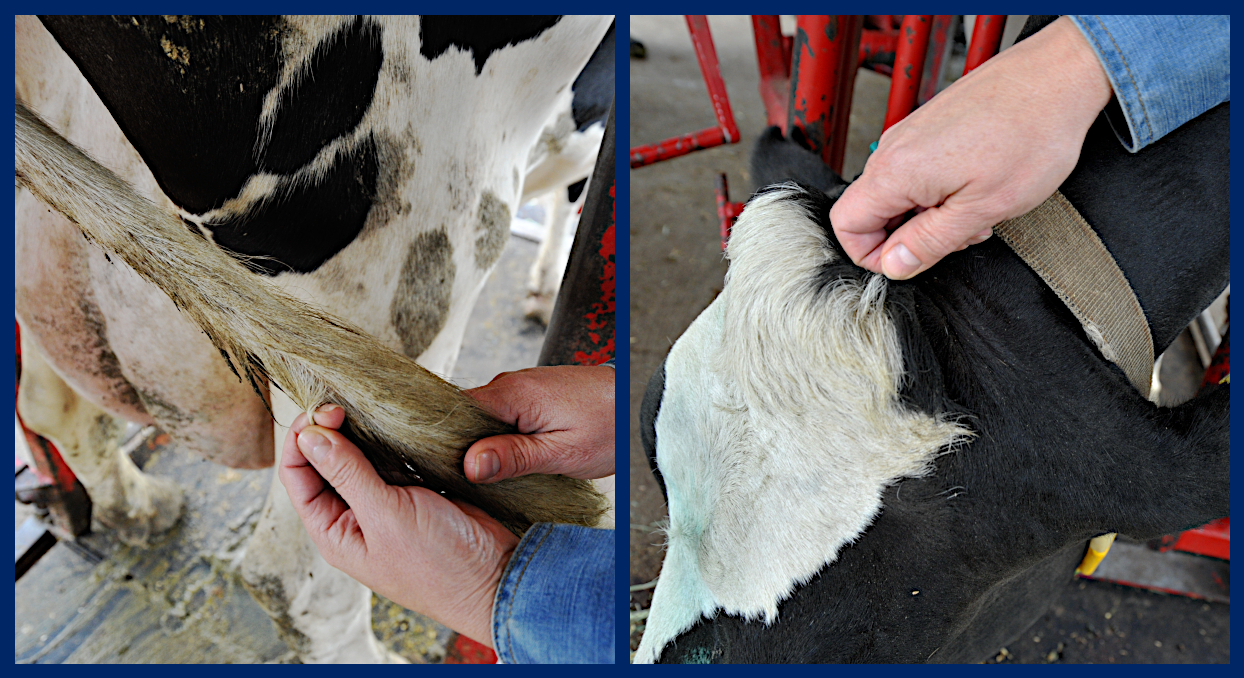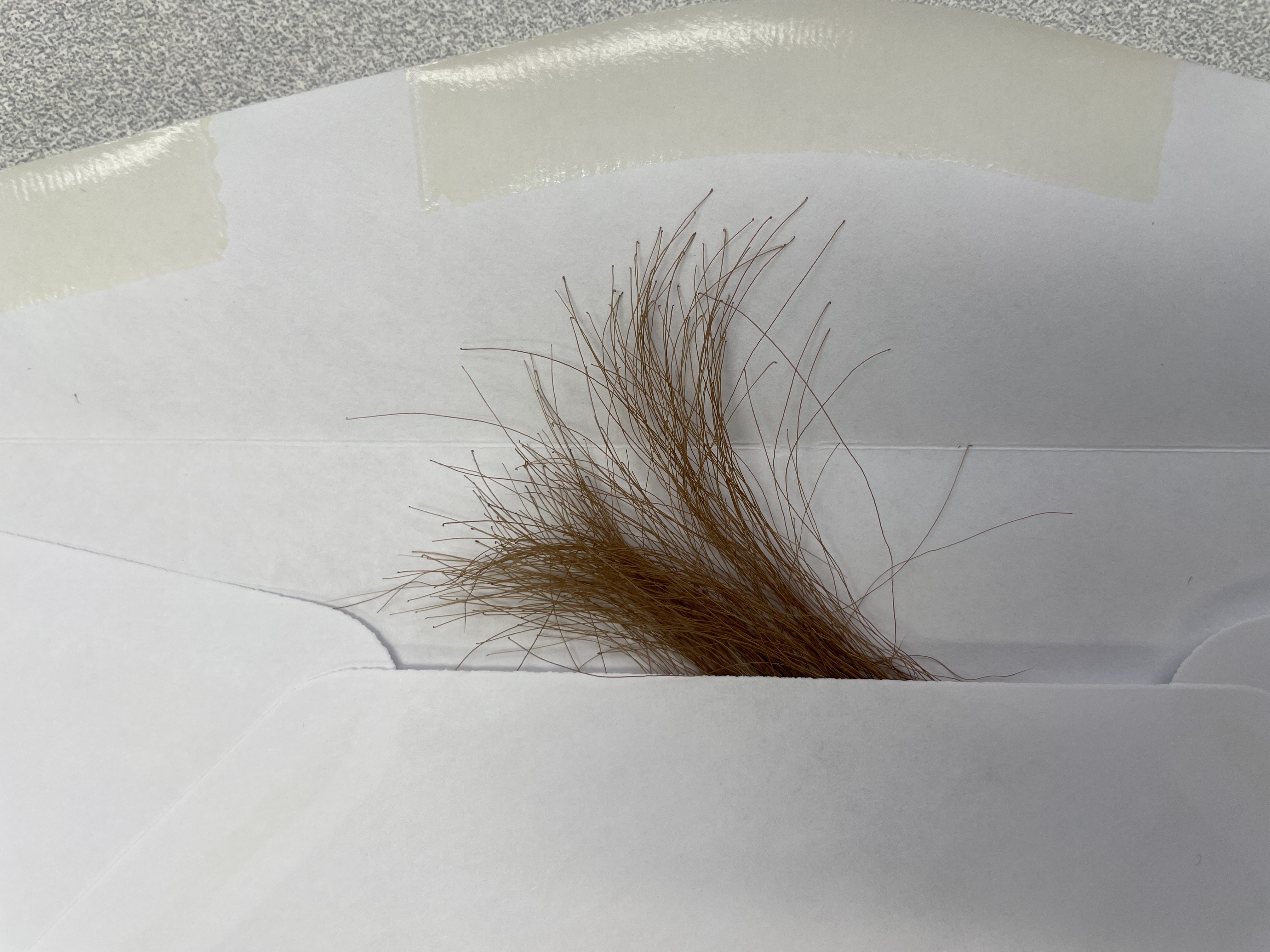Quick Summary
Phenotype: A recessive genotype at the SLC45A2 locus (C/C) results in a chocolate color similar to Dexter dun when present in black cattle, or a cream color in otherwise red cattle.
Mode of Inheritance: Autosomal recessive
Alleles: N = Normal, C = Dilution
Breeds appropriate for testing: Dexter and Dexter crosses
Explanation of results:
• Cattle with N/N genotype do not exhibit diluted hair color. They cannot transmit a dilution variant to their offspring.
• Cattle with N/C genotype do not exhibit diluted pigmentation in their coats. They will transmit this Dexter dilution variant to 50% of their offspring. Matings between two N/C animals have a 25% chance of producing a calf with a diluted coat.
• Cattle with C/C genotype will exhibit diluted pigmentation in their coats. They will transmit this Dexter dilution variant to all their offspring.
Sample Collection
Most of the cattle DNA tests offered by the VGL are carried out using cells from the roots of a hair sample (roughly 20-40 hairs).
Hair samples should be taken from the switch of the tail, the poll, or the neck.

1. Clean (use comb if possible) tail switch, poll, or neck by removing all loose hair and foreign matter.
2. Use fingers or pliers to grasp approximately 8-10 hairs close to the skin and pull. Pull (do NOT cut) hair strands. Examine the end of hair strands for presence of root bulbs. Hair roots are necessary for DNA testing. If the majority of hair strands lack the root bulbs, discard hair and start again.
3. Repeat until you have approximately 20-40 hairs with root follicles attached.
4. Place the 20-40 hairs with root follicles attached in the envelope and seal with the animal’s ID written on the envelope. If hairs are long they can be taped to the submission form. Do not tape the roots.

5. Repeat steps 1-4 for each additional animal being sampled.
Note:
- Hair should be dry.
- If hair has excess dirt and debris, please brush out if possible before pulling hairs for sample.
- Do not cut the hair! The roots contain the DNA for testing.
- When sampling several animals in the same session, make sure that there are no hair strands in your hands to reduce the possibility of sample contamination. Clean hands and/or pliers if possible.
The previously identified dun coat color in Dexter cattle is determined by a recessive mutation of the gene TYRP1. The dun genotype (b/b) is only visible in otherwise black Dexter cattle (those with MC1R genotype ED/_); it is not expressed in Dexter cattle that are red (those with MC1R genotypes E+/E+, E+/e, e/e).
As far back as the late 1800s, there were accounts of black Dexter cattle that produced “chocolate” offspring, and red Dexter cattle that produced yellow offspring. These phenotypes were thought to have been selectively bred out of the population. However, in the 2010s, reports began circulating that these dilute coat colors had resurfaced. Providing additional evidence that the chocolate and yellow (“cream”) coat colors differ from dun, Dexter cattle that appeared as and were assumed to be dun were confirmed to be B/B or B/b at the TYRP1 locus. Inheritance patterns suggested that the chocolate/cream dilution was inherited recessively.
Fuller and colleagues identified a single nucleotide change in the gene SLC45A2 (also called MATP) that explained the chocolate and cream color of Dexter cattle. The mutation causes an amino acid change (XP_002696432.2: p:Gln133Pro) that is predicted to alter the function of the protein. The MATP protein produced by SLC45A2 is important for maintaining the pH of melanosomes within melanocytes, the cells that produce pigment. It is hypothesized that the altered environment created by the SLC45A2 C/C genotype leads to reduced pigment production, which in black Dexter cattle creates the chocolate phenotype and in red Dexter cattle results in cream. To date, this mutation has not been identified in any other breed.
The SLC45A2 mutation is inherited independently from the TYRP1 dun mutation. Thus far, no cattle have been observed to be homozygous for both dilution alleles (i.e., SLC45A2 C/C and TYRP1 b/b) and it is therefore not known if having both dilution genotypes further alters coat color or has other effects on the animal. Dexter cattle with the SLC45A2 C/C genotype have been identified that are also carriers of dun (B/b), and dun cattle (b/b) that are carriers of chocolate/cream (N/C), with no obvious impact on their coat color or other traits.
A DNA test is available to determine if the SLC45A2 variant is present. This test is appropriate for Dexter cattle, especially those that appear dun in color but do not have the TYRP1 b/b genotype.
